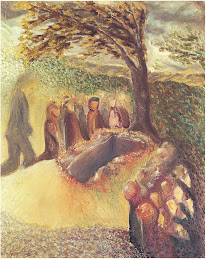Today I presented a piece that I wrote last week. Overall I would say that I am very happy with the outcome. The piece features a very simple melodic line which is developed and contrasted. It is only a page and a half in length and i feel that this piece is is the most consistent thing I have written. One idea, it does not over state itself, it does not exist longer than it should.
Some comments I received,
- mm. 16 - 19 - I feature a passage in the bass clef. This is the only instance that this low register is used in the entire piece. Perhaps I could find a more effective way of creating a thicker texture while still sticking to the upper registers.
- The 5/8 passages were good!, But do not sound like 5/8 at all
- Pause at mm. 39 could be extended. This would play with the listeners expectations
Tuesday, January 26, 2010
Thursday, January 21, 2010
Presentation 2 (POST 3)
On tuesday I presented my second "piece". I recieved several helpful comments.
What I learned,
- I have several ideas, 4 to be exact. Each one could potentially stand alone as a seperate piece.
- Ideas 3&4 were most unified, both feature arpeggio passages that repeat. I should take these and further develop them.
- Since I am only using a certain unmber of chords, I could write out the pitches as block chords and listen to differnet voicings, while adding and subrtacting notes. This could help me develop more chords that could be introduced as the idea develops.
- My second idea, although written in 3/4, is very ambiguos, it is very challenging to feel the down beats or any regular pulse. This could be a piece on its own
What I learned,
- I have several ideas, 4 to be exact. Each one could potentially stand alone as a seperate piece.
- Ideas 3&4 were most unified, both feature arpeggio passages that repeat. I should take these and further develop them.
- Since I am only using a certain unmber of chords, I could write out the pitches as block chords and listen to differnet voicings, while adding and subrtacting notes. This could help me develop more chords that could be introduced as the idea develops.
- My second idea, although written in 3/4, is very ambiguos, it is very challenging to feel the down beats or any regular pulse. This could be a piece on its own
Thursday, January 14, 2010
Understanding the Keyboard (POST2)
The keyboard has essentially become the center piece of western classical music. It is supposed to be every composers best friend. The perfect instrument.
Since I play guitar and am a very poor pianist, it is a challenge for me to write good flowing music that fits onto a keyboard. It is a completely different way of thinking. Two hands which have many possibilities.
I started listening and examining scores from great keyboard composers from the past. I took ideas and passages that I liked and modified them to make them my own. Most notably
- Scarlatti - K. 14 in G Major
- Chopin - Prelude No. 15 Op. 28
- Rachmaninoff Etude - Tableaux Op.33 No.2
- Liszt - Three Concert Etudes S.144 No.3 "Un Sospiro"
- Scriabin - Vers la flamme, Op.72
Since I play guitar and am a very poor pianist, it is a challenge for me to write good flowing music that fits onto a keyboard. It is a completely different way of thinking. Two hands which have many possibilities.
I started listening and examining scores from great keyboard composers from the past. I took ideas and passages that I liked and modified them to make them my own. Most notably
- Scarlatti - K. 14 in G Major
- Chopin - Prelude No. 15 Op. 28
- Rachmaninoff Etude - Tableaux Op.33 No.2
- Liszt - Three Concert Etudes S.144 No.3 "Un Sospiro"
- Scriabin - Vers la flamme, Op.72
Writing for Piano (POST1)
Upon recieveing the assignment (write 3 short pieces for piano) I thought I would get a head start and compose as much as I could before the first presentaiton day. I ended up with two ideas, both a page each which will serve as a skeleton to two pieces.
The first is based upon a 5/8 pattern in which is repeated several times while a second voice plays over it creating thick texture. This can be further developed by rhythmic manipulation.
The second is basically a set of arrpegios based on a lydian scale that eventually modulates. I am especially pleased with this sketch.
The first is based upon a 5/8 pattern in which is repeated several times while a second voice plays over it creating thick texture. This can be further developed by rhythmic manipulation.
The second is basically a set of arrpegios based on a lydian scale that eventually modulates. I am especially pleased with this sketch.
Subscribe to:
Comments (Atom)
